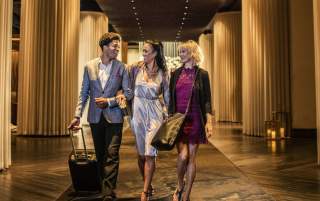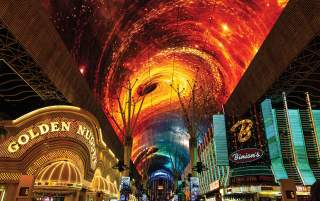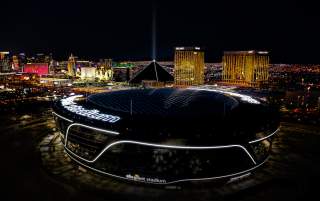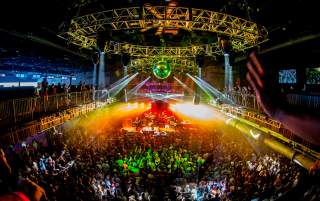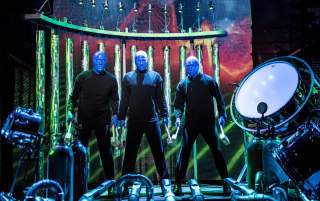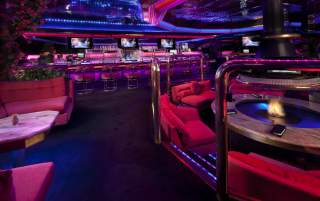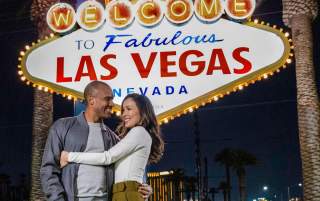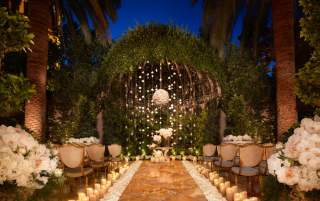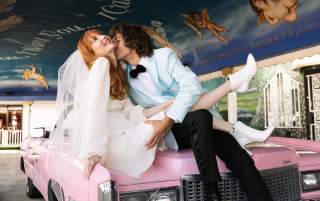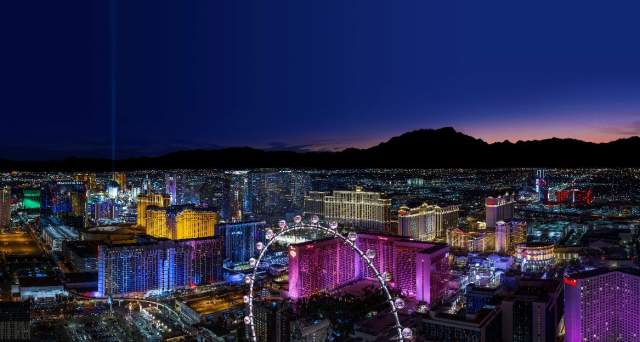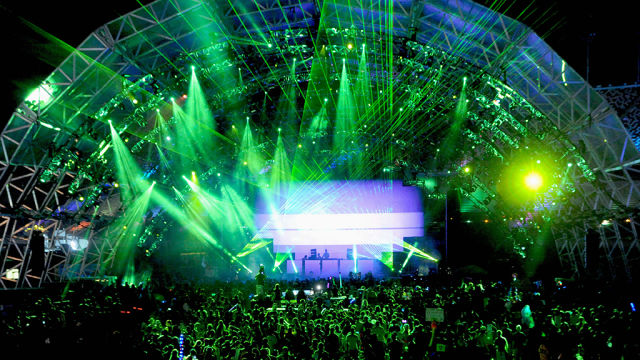What house did the Rat Pack rule? From the lounge acts of the 1950s, to the nightclub residencies of today, we’re going to give you a crash course in the entertainment history of Las Vegas.
It began in a lounge
In 1950s Las Vegas, then a city of less than 50,000 people, rapidly became the destination to see the world’s top entertainers. Visitors could catch stars like Liberace, Elvis Presley and Don Rickles for as little as $5. The shows often included drinks and a dinner menu.
At the Fremont Hotel and Casino in 1958, the future Mr. Las Vegas, Wayne Newton, then a high school student, booked six shows a day, an engagement that stretched out for five years. He would perform more than 30,000 shows in his new hometown over the next decades.
At the same time, Frank Sinatra and the Rat Pack – Dean Martin, Sammy Davis Jr., Peter Lawford and Joey Bishop – were turning the city onto its head. The draw of the Rat Pack was so high, marquees would play off the group’s notoriety for crashing the shows of one another.
“Dean Martin, Maybe Frank, Maybe Sammy,” read a marquee at The Sands in 1963, according to an archived photo.
The spontaneity of these shows became a blueprint for acts in Vegas for generations.
“They weren’t out there just doing the same thing like everybody else was,” said Oscar Goodman, Las Vegas’ former mayor, who moved to the city in 1964. “They had their own personality, their own way of doing things. They were enchanting.”
Headdresses, rhinestones and high kicks
In the late 1950s, shows at the casino became more lavish.
Tall, beautiful, and covered in rhinestones, showgirls emerged as a result. Previously serving as backup, the ladies were becoming the main attraction and would define Vegas’ style for generations. “Les Folies Bergere” opened at Tropicana Las Vegas in 1959, offering a Parisian spin on the revue and solidifying the showgirl as a Las Vegas icon. The production would run for 50 years, closing in 2009.
Along with acts like Liberace and Elvis in the 1960s and 1970s, the showgirls rewrote the public’s image of Las Vegas to one of rhinestones, sequins, and over-the-top showmanship.
Donn Arden’s Jubilee! at Horseshoe Las Vegas, a $10 million production in 1981, would run for 35 years until it closed in 2016. The show featured a 27-foot-tall bull, the sinking of the Titanic, and headdresses weighing in the double digits.
The rise of the variety shows, magicians and circus performers
The 1990s brought new variety to Las Vegas, as magicians, circus performers, and even a group of men painted blue, captured imaginations. Here, acts could take risks.
Siegfried & Roy debuted their mystifying show of illusions—complete with white Bengal tigers—at The Mirage in 1990. The show was grand in scale and budget, clocking in as one of the most expensive entertainment productions in history at the time.
Magic took many forms in Las Vegas, with varying type of illusionists premiering up, down and off the Strip throughout a time marked by extensive development in the resort corridor.
Whether catching a bullet, or sawing a woman in half, Penn & Teller used sleight of hand that respected the audiences’ intelligence—they weren’t afraid to explain the trick. The duo brought their show to Vegas in 1989 and are still performing here today.
“In Vegas, we got stronger, we got weirder, we got braver,” Jillette said.
Not long after Penn & Teller got their start, the thrilling Cirque du Soleil made its Las Vegas debut with Nouvelle Expérience under a tent behind the Mirage Hotel. The successful run caught the eye of Steve Wynn, who wanted to bring the production permanently to the then yet-to-be-finished Treasure Island Hotel.
Mystère opened in 1993 in a theater at Treasure Island built to the production’s specifications. Today, Cirque has several shows playing in Vegas on a permanent basis, including shows in partnership with The Beatles and the Michael Jackson estate.
Offering a mix of the circus, acrobatics, theater and opera, Cirque’s shows offer an escape to an awe-inspiring world with fantastical settings and stunts. Its massive productions have something for everyone.
The return to residencies
In the early 2000s, Las Vegas circled back to booking the biggest entertainers for pumped up residencies: Cher, the Backstreet Boys and Enrique Iglesias.
As pop artists filled arenas, electronic dance music rose in popularity in Las Vegas’ underground scene. Everything would change when Paul Oakenfold took up residency with Perfecto at Rain in 2008—with light shows, aerialists, and stilt walkers, the world-famous DJ’s show came with a uniquely Vegas flashiness.
Electronic dance music blows up in Las Vegas
EDM-focused clubs popped up one after another, as these residencies became the norm. Today, Las Vegas draws in the biggest names in EDM like Tiësto, Zedd, Diplo, and Steve Aoki.
One of the big turning points for electronic dance music scene came when Electric Daisy Carnival moved to Las Vegas in 2011. The music festival draws more than 400,000 people each year to the Las Vegas Motor Speedway and continues to grow. The elaborate festival features carnival rides, sky-high art installations, light shows and pyrotechnics.
“It helped contribute to it being the epicenter for dance music lovers and travelers who were willing to venture to see their favorite artists,” said Pasquale Rotella, the founder and creator of Insomniac, in 2016.
New venues, new opportunities, new experiences
From the end of the 2010s to the early 2020s, several new venues were built throughout Las Vegas, drastically changing the entertainment landscape again. Among the many were T-Mobile Arena (2016) and Allegiant Stadium (2020), allowing the destination to host stadium-scale concerts and even more electrifying arena shows—in addition to becoming the home for the NHL’s Vegas Golden Knights and the NFL’s Las Vegas Raiders, respectively. By the end of 2022, the two venues will have hosted concerts from world-class entertainers like Billy Joel, Billie Eilish, Metallica, Justin Bieber, Red Hot Chili Peppers and Dua Lipa.
In addition to the new venues, a brand-new music festival launched in Las Vegas in 2013. The Life Is Beautiful Music & Art Festival brings today’s top acts to the blocks of Downtown Las Vegas, with recent headliners including Gorillaz, Green Day, Muse, Lorde, Wiz Khalifa and so many more. The festival also draws international street artists, transforming the DTLV neighborhood into a walking mural art museum.
And the evolution doesn’t end there! As the Entertainment Capital of the World continues to captivate, it also continues to catch the eye of the planet’s most beloved stars. The arrival of Resorts World Las Vegas brought a roster of residencies sure to impress any live music fan, including Carrie Underwood and Luke Bryan. Dolby Live at Park MGM, which opened as Park Theater in 2016, has played host to the likes of Lady Gaga, Bruno Mars, Cher and Ricky Martin.
What’s next?
Las Vegas has never followed the trends; it has set them. And, by all accounts, it’s expected to keep doing that in the future.
One such way it will do just that is with the MSG Sphere, a brand-new medium and multi-sensory platform for today’s top artists. A partnership between Madison Square Garden Entertainment, The Venetian Resort Las Vegas, Las Vegas Sands Corp. and Tao Group Hospitality, the space will be the largest spherical structure on earth with a capacity of 20,000—plus state-of-the-art audio and visual effects.
Sounds a little like the future of entertainment, right? Well, that’s Vegas for you!
